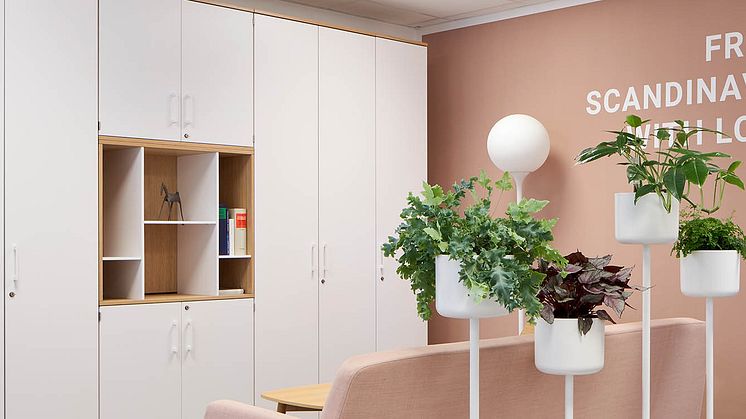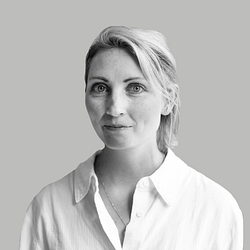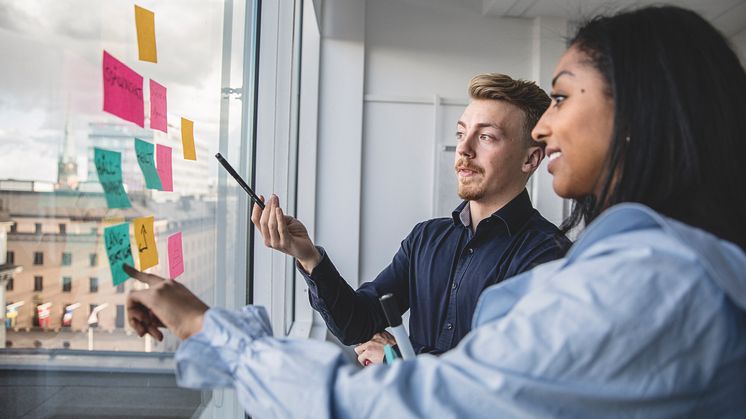
Blogginlägg -
Redefining the workplace - a visionary outlook on the office from Kinnarps
Interior design company Kinnarps originated as a family owned business (and still is to this day) from Sweden - and is now a synonym internationally for ergonomics and quality. We have met with Henrik Axell, Workplace strategist, and Johanna Walden, Brand and concept marketing manager, to hear their thoughts on how we can redefine the workplace post-pandemic.
DURABLE AND ENDURABLE
Founded in 1942, by married couple Jarl and Evy Andersson, Kinnarps AB began producing interior design solutions for public spaces. Today, almost 80 years later, the guiding values from Jarl and Evy lives on; to create sustainable and ergonomic environments for the people using it.
As in other segments of society, there have been some milestones and trends in the world of the office spaces as well. The interior fitting of the room has varied from single office spaces, to office landscapes and “flex offices”. Together with inventions, such as the sit-and-stand table, interior design and ergonomics has been an interesting topic for all organisations operating in public spaces for quite some time.
– We have always been very far ahead in ergonomics, and it is one of the corner stones in our workplace analysis Next Office® that we have developed since many years back, says Henrik Axell, Workplace strategist at Kinnarps. What I think is the biggest difference, in this paradigm shift we are experiencing, is that technology allows us to be space-independent. Fifteen years ago we were tied to a desk, but now technology has made it possible for us to choose the optimal work environment based on which work activity I am to perform. It is a huge development, that you can choose a place and access all your material from there.
CHANGING THE VOCABULARY
When times are changing, so is semantics. Concepts and values need to adapt to present prerequisites, in order to stay relevant. Kinnarps know this, and has altered the vocabulary accordingly. Henrik Axell explains;
– A few years ago, the word workplace was very much associated with the desk. The workplace today is all the environments in the office. When we plan offices today, instead of talking of a "meeting room", we talk about a "meeting space”. We want to introduce the idea that you can have meetings in open spaces, which can be delimited with the help of textiles or partitioning storage, screens or highbacked sofas.
If you come to work, it is so much more appealing to see your colleagues, than for everyone to be trapped inside small rooms.
The open spaces also allows different departments of the organization to interact more freely, contributing to a more inclusive workplace culture. It is also a possibility to adapt to quick changes in the daily operations.
– This is why going from “room” to “space” is an illustrative way of describing this way of regarding the workplace, says Johanna Walden. If the interior design solution is well planned from the beginning, according to mapped needs and way of working, to be able to change and adapt, then we have a much more sustainable and future proof work environment. And it is also good for the people who will work there, because you can alter according to changing needs.

ANALYSING THE OFFICE
So, how can an organisation or business design their interior for best possible outcome for their staff and operations? Is there a general solution that will fix it all? The answer is, no – you must first know your needs. Luckily, Kinnarps can help you.
– Our workplace analysis Next Office® is the tool we use to help our clients make the best investment, says Henrik Axell. It is a thorough process that we have applied on over 250 different office clients internationally. The path to our customers' new office is relatively similar, but the results vary a lot. We start with a well-established methodology where we talk about vision and goals with the management, what will this company do and how will they do it?
A great part of the process is to get the staff informed and involved in a well-planned and thought out way in the different stages of the progression.
– We clearly, together with the client, state the different phases of the process where different groups of the staff will get information; in which channel and at what time, says Johanna Walden. Because, very often – this is not just about furniture, a redecoration of this sort can also mean new ways of working and new routines. For that you need a long-term plan to make the staff comprehend why this is important, and get them onboard. Involving in this case is not about choosing colour on your desk, it is to have a very structured and clear plan for all employees about the goals of the new environments and what possiblities they hold.
A common obstacle when working with interior design is the will from the client to jump to the solution at once, and start decorating immediately - instead of analysing the needs of the company first.
– We do love the enthusiasm, says Henrik Axell. But for us, we want to emphasise the farsightedness and create a sustainable solution that helps the operations and staff in the long run. Not start with picking the colour for the walls, that is the icing on the cake.
BACK TO THE FUTURE?
The past year, many organisations and businesses has worked totally or partially from home, with all the challenges and advantages that may include. This has created a debate on whether or not to have an office space at all, with different pros and cons supporting the opposite sides. The most likely scenario is to have a mix between the two; with a flexible way of working where the office is the central hub for cooperation, creativity and, not the least, nurturing the culture of the organisation. Henrik Axell develops;
– The pandemic has really made us reflect on what we should have the office for. We believe it will be just as important as it was before the pandemic. It is a place to meet your co-workers for collaborations, and a place for high focus work in privacy. The office should be the optimal environment for both. It’s all about identifying what kind of environments your specific business needs.
Not only is the flexible and adapted solution important on the road ahead. So is sustainability.
Johanna Walden explains:
– Something that warms our heart is that we are starting to see a shift in how public environments is procured nowadays, at least in Scandinavia. Previously there has been a strong focus on price, but now we see other types of evaluation parameters such as durability, flexibility and ergonomics. I believe that this is an indication that society actually value other things than economics and understand that they need to see the total life cycle cost instead of the price right here and now.
So with this stated, does Kinnarps have an answer on how the utopian workplace of the future looks?
– Yes, I think it's very simple! says Henrik Axell with a smile. There is not one utopian office, but many and they are designed according to each unique organisation’s well-mapped needs. And if you keep flexibility, sustainability and ergonomics in mind while planning it - you will get a really good office.
Text: Maria Vårenius
Photo: Kinnarps


